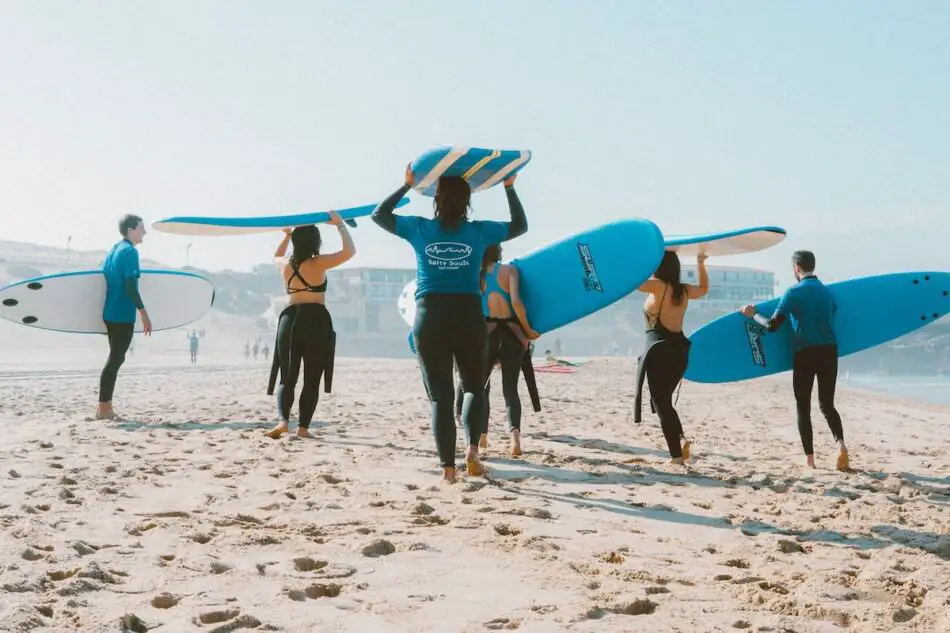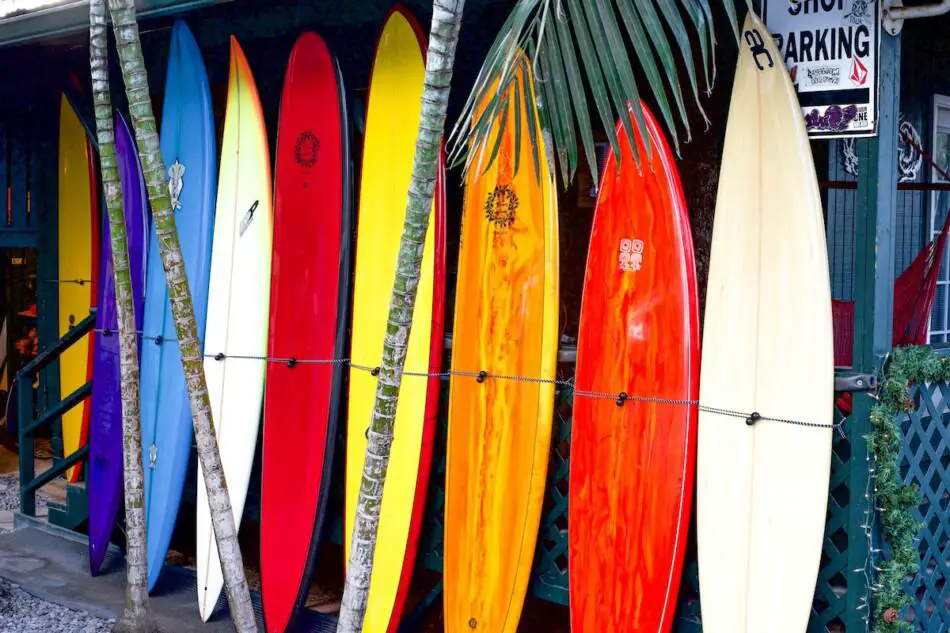Surf’s up! Or it will be once you learn to surf. Some people have serious trouble finding a decent surfing teacher at a reasonable price.
Others want to save the embarrassment of being coached at arguably the coolest sport ever.
As a result, the question on many people’s tongues is whether or not it is possible to learn how to surf on their own.
Although it won’t be an easy process, you can learn to surf on your own. It will take a lot of self-discipline and commitment, but with fellow surfers and other helpful resources (both online and at your local surfing spots), you can teach yourself how to surf.
Surfing is a sport that has consumed many people’s lives (in a good way), and it’s hardly tough to imagine why.
Anyone who has spent enough time gazing out at an ocean full of suited-up adrenaline lovers knows what the attraction is.
Following this guide and finding the heart to commit, you will soon be on your way to joining the ranks of those salty-haired rascals.
Can You Learn To Surf On Your Own?
Certainly! These days you can teach yourself nearly anything, especially with the help of the internet and its trustee users.
With something like surfing, an instructor can try and give you all the tricks at their disposal and teach you every possible technique they can think of, but eventually, you will have to figure it out and practice for yourself.
Therefore, you can learn to surf on your own – that is, if you don’t count watching YouTube tutorials or other surfers on the beach as being taught by someone else.
The 5% start will come from outside help like online sources and friendly tips, but the other 95% of learning will come from your determination and willpower.
Well, that and hours upon hours of practice in and out of the water.
-> Read Also What Is An Autodidact?
How To Teach Yourself To Surf: A Step By Step Guide
Teaching yourself to surf is no easy feat. Even people who have been coached for months to years sometimes have difficulty in the water. So, mental preparation for the task at hand is extremely important.
Learning to surf must be something important to you; otherwise, what will stop you from throwing in the towel? It’s alright to give up on something that isn’t too serious, but with these steps listed below, you won’t have to.
Hopefully, this guide will help you gain the confidence needed to tackle the treacherous yet exciting waters you will someday surf.

1. Understand The Dangers Of The Ocean And Surfing
The ocean is possibly one of the most dangerous places a person could find themselves. Although a nice beach provides much more safety than the deep sea, you should always be aware of what may be lurking around.
Please don’t understand it wrong – just because something lurks doesn’t necessarily mean it’s alive. Sometimes the most dangerous adversary on a beach could be the rocks or urchins you don’t see on your way in.
Even the visible boulders can become the greatest enemy when the tide picks up or down.
Therefore, you must become acquainted with the ocean and the dangers it can hold. Always look out for signs of danger (rocks, sharks, seals, jellyfish, strong ocean streams, etc.), and eventually, you will pick it up as second nature.
Although many people think the surfboard is their safe floating device, it can be equally dangerous as the sea.
Some surfers need to take a few knocks to get it in their head, but if a wave crashes a surfboard into your skull, you will know what we mean.
2. Exercise Your Swimming, Paddling, And Breathing
To be a good surfer, you don’t necessarily need to be the fastest swimmer, but you need to be stronger than the average person in the water.
A strong ability to maneuver in the sea is important to prevent getting carried away by underwater streams and to get back to the surface after a wave has pushed you far down. For that same reason, you will need to practice holding your breath.
There are various ways to train water apnea (suspending your breath underwater). Try doing it in your bath, pool, or a nearby beach. Don’t push yourself too much at first.
Focus on training endurance and getting more confident spending time underwater. Other than that, train your upper arm strength. You should be able to catch your wave with six simple strokes in the water.

3. Look For Good Surfing Spots Near You
Getting started with surfing can be quite daunting, especially when you try it out at a beach where the waves don’t suit your skill level yet.
Look for a beach where the break is small, slow, and broad.
Ensure that the waves still have enough power to carry the weight of you and your board.
Often it is a good idea to go into the water without a board at first to get a feeling for the waves. If you know how to body surf, you probably already know what to do, but if you don’t yet know how, give it a try first.
Going in with fins to give you extra kicking power will make it a lot easier, but remember that you won’t be able to wear fins when you’re in the water.
– > Read also Can You Learn To Kiteboard On Your Own?
4. Get To Know The Weather’s Impact On Surfing Conditions
The weather and, most specifically, the wind will greatly impact the waves and, resultingly, the surfing conditions.
Surfers will usually look for offshore winds (i.e., winds that originate inland) as they push the incoming waves back to form a better shape for surfing. When the wind blows strong enough, it may create barrels on certain beaches.
Conversely, onshore winds will flatten your waves and often make them un-surfable. The wind also impacts the swell. The swell impacts the size of the waves, and as a beginner, you would likely be looking for a 3ft (1 meter) swell.
The swell period refers to the frequency of the waves relative to time. A lower frequency is more suited for beginners.
A higher swell period means waves are crashing more frequently, giving surfers less time to recover between sets and making the ocean more chaotic.
If the set period is too short, you will struggle to get behind the break and find a suitable wave to ride.

5. Find The Perfect Board And Other Surfing Gear For You
Technically, all you need to surf is yourself and a surfboard. For beginners, we recommend a larger surfboard. A thicker and more broadly shaped longboard will provide beginners with the stability they need to get used to balancing on a mobile board.
Furthermore, smaller waves and your standard paddling power will carry these boards with more ease.
Surfboards can be constructed from various materials, but the most common options are Polyurethane (fiberglass) or Epoxy surfboards.
We recommend using epoxy surfboards as they are more resistant to bumps and scratches and are likely to endure the pain a beginner may accidentally put its board through.
Soft top boards (also known as floaties) are made similarly to Epoxy boards with the added Ethylene-Vinyl Acetate (EVA) layer.
This sheet of EVA covering the board is very soft and can withstand dents, reducing the amount of damage the board (and likely your body) will sustain.
A soft top board will be indispensable for beginners that will likely fall on top or get bumped by their board a lot.
In some colder areas, you will need a wetsuit to survive in the water for a prolonged period (unless you are some superhuman).
Therefore, consider investing in a multi-purpose wetsuit. You can use these for a range of activities requiring swimming or diving in cold water.
– > Read also Is It Easy To Teach Yourself How To Snowboard?
6. Become Acquainted With Surfing Etiquette In Your Area
Surfing etiquette is integral in surfing culture, and if you don’t take the time to read up on the ways around the waves, you may upset your fellow surfers.
Ask the surfers around your area about their specific rules since many of these things differ around the world (and sometimes from one beach to the next).
Respect these rules, and you (and your mates) are sure to have a lot more fun. If you fail, you may risk serious injury to yourself, or the regular beachgoers may perceive you as being woefully selfish.
These rules apply to all surfers, from beginners to pros.

Rule 1: Don’t Drop In On Someone Else’s Wave
If another surfer caught a wave before you did, it’s theirs. “Dropping in” on a wave refers to taking the same wave as someone who has already landed it and resultingly getting in their way.
The general rule is that one person is allowed per wave unless it breaks in both directions (in which case one would take a left and the other would take a right).
Everyone has seen someone drop in on someone else’s wave, and the aftermath is rarely pretty. From damaged boards to heads cut open – it is clear to see why these rules are put in place. Many will excuse beginners for this kind of misconduct, but if you cross this line, it is fair to expect a stern scalding from other surfers.
Rule 2: The Right Of Way
Believe it or not, just like the road, surfing also has the right of way. This one has to do with the surfer’s relative position to the peak of the wave. The peak is the part of the wave where the white foam first starts to form.
Right of way is awarded to the surfer close to the wave’s peak. Only if he shows no intention of taking it does he forfeit that right to the next in line (and so forth).
Rule 3: Don’t Push In Line
Also known as “snaking,” this rule refers to swimming past other surfers to get closer to the peak instead of waiting for your fair turn.
Stealing someone else’s right of way is just as bad as dropping in on someone’s wave (though not as dangerous). Still, it is blatantly disrespectful and should be avoided unless someone explicitly tells you to pass through.
Rule 4: Avoid Getting In The Way
When paddling in to get behind the break, it is best to paddle far wide of the peak. Paddling is done this way to avoid getting in the way of fellow surfers catching a wave and avoiding injuries.
The sea’s streams will often carry you in when you are wider from the peak, easing your job of getting behind the break; however, every beach is different, and it doesn’t always work.
Rule 5: Respect The Ocean And Your Fellow Surfers
Do not ever litter in the ocean; if you see plastic or other oddities floating around in the water, you may gain respect for picking it up.
Communicate with your fellow surfers when there is confusion regarding a wave, and try and be as civil as possible. The experience will be more enjoyable for everyone.
There are many other rules regarding surfing etiquette, and since they differ from place to place, ask your surfer friends or the next person you end up floating next to behind the break. They’d be happy to help since they’d benefit if you knew the rules.
-> Learn more about the 7 best websites for self-learning
7. Pick The Right Day And Try Your Luck With Some Waves
Now that you know the perfect conditions, which spots will suit your needs, and you have your board and suit with you, it is time to hit the beach.
If you set out to go on a certain day and the weather forecast doesn’t seem too great, going anyway won’t hurt! Often the best waves are found on the worst days – drive past a couple of beaches and see what’s cooking.
8. Practice Catching A Wave On Your Stomach First
It’ll be great to get used to the feeling of a wave pushing your board around by not trying to stand up at first. Like boogie boarders, try to catch a wave on your stomach and ride it to the shore.
The focus is not to let your board nosedive, as this will result in an embarrassing bail.
Once you get the feeling of catching a wave on your stomach, try slowly lifting your body from the board and tucking your knees in under your torso.
Knee boarding is a great way to practice standing up without adding all of the imbalances that increased gravitational stress causes from standing up fully.
9. Stand Up On The Board And Try To Balance
One way many beginners get taught to stand up on their board is on the shore (and without a board)! Draw a surfboard shape in the sand, about the size of your chosen piece, and lie down flat in the center.
Now, push yourself up and get into the surfing position – one foot in front of the other. This process may sound silly but combine it with visualizing, and you have quality practice.
Switching between this technique, knee boarding, and trying to stand up repeatedly will soon have you on your feet in the water, catching your first wave.
Don’t try fancy tricks at first; enjoy the moment and ride out the wave as long as possible. The feeling of catching your first couple of waves is something that few surfers can ever replicate in the water again.
10. Gain Confidence And Try To Ride Bigger Waves
Like many other things in life, surfing is highly dependent on confidence if you want to grow. If you could stand up once, you’d be able to do it again.
If you could catch a three-foot wave, you’ll eventually be able to catch a six-foot-one. Keep practicing, and after some time (maybe quite a long time), you’ll be one of the revered surfers at your local spot – one of those you once looked up to and learned from.
-> Learn More about Self-Learning vs. Classroom Learning: Which Is Better?
Conclusion
Since we know that you can teach yourself to surf, nothing should be holding you back.
Please take special note of its possible dangers, be prepared for the weather and your gear, and keep practicing.
Eventually, you will come out on top!






